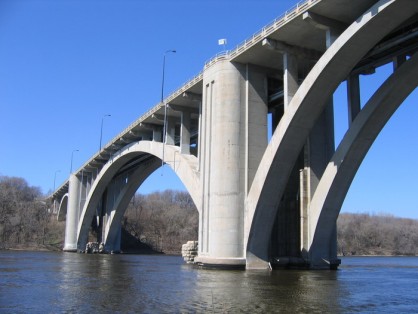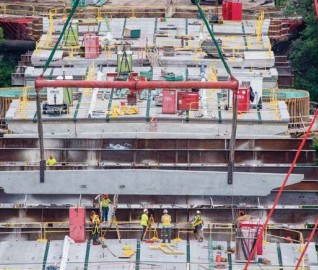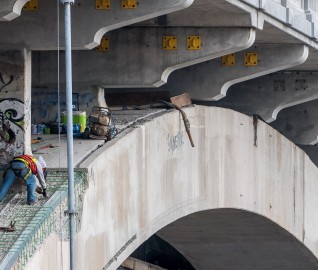
Open-spandrel, concrete arch bridges were common designs in the United States during the early 1900s. The long spans and tall profiles characteristic of this bridge type are well suited to a topography of deep ravines and river valleys. One of these arch bridges, the Franklin Avenue Bridge, was constructed from 1919 to 1923. It is located near Minneapolis and St. Paul, MN, crossing over the Mississippi River Valley with five elegant arch spans.
The rehabilitation of the bridge, beginning in 2007, was firmly rooted in a comprehensive investigation of the condition, performance, and historical importance of the structure.
In the first of a two-part series, materials engineer John Lawler and structural engineer Arne Johnson detail the investigation phase and rehabilitation design for the restoration of this historic structure.
This article is republished courtesy of the American Concrete Institute.
RELATED INFORMATION
-
 Our knowledge of bridge performance is supported by technical expertise in structural... MORE >Services | Bridge Engineering
Our knowledge of bridge performance is supported by technical expertise in structural... MORE >Services | Bridge Engineering -
 Our professionals deliver practical repair and rehabilitation services that maximize the... MORE >Services | Repair and Rehabilitation
Our professionals deliver practical repair and rehabilitation services that maximize the... MORE >Services | Repair and Rehabilitation -
 Our professionals balance the need to provide practical, long-term solutions with the ability to... MORE >Services | Historic Preservation
Our professionals balance the need to provide practical, long-term solutions with the ability to... MORE >Services | Historic Preservation -
 Arne P. Johnson, PrincipalWJE Northbrook MORE >People | Arne P. Johnson, Principal
Arne P. Johnson, PrincipalWJE Northbrook MORE >People | Arne P. Johnson, Principal -
 John S. Lawler, PrincipalWJE Northbrook MORE >People | John S. Lawler, Principal
John S. Lawler, PrincipalWJE Northbrook MORE >People | John S. Lawler, Principal -
 Degradation and changing usage led to the full replacement of the deck and spandrel cap beams. MORE >Articles | Franklin Avenue Bridge: Analysis, Design, and Accelerated Bridge Construction
Degradation and changing usage led to the full replacement of the deck and spandrel cap beams. MORE >Articles | Franklin Avenue Bridge: Analysis, Design, and Accelerated Bridge Construction -
 Investigation and rehabilitation design of this historic Minneapolis bridge (part 2 of 2) MORE >Articles | The Franklin Avenue Bridge—Part 2: Structural Analysis and Accelerated Bridge Construction
Investigation and rehabilitation design of this historic Minneapolis bridge (part 2 of 2) MORE >Articles | The Franklin Avenue Bridge—Part 2: Structural Analysis and Accelerated Bridge Construction -
 Structural Investigation and Rehabilitation Design MORE >Projects | Franklin Avenue Bridge
Structural Investigation and Rehabilitation Design MORE >Projects | Franklin Avenue Bridge



































